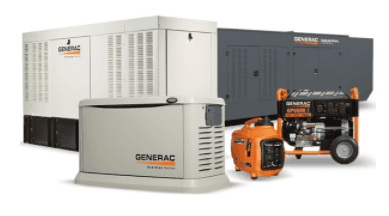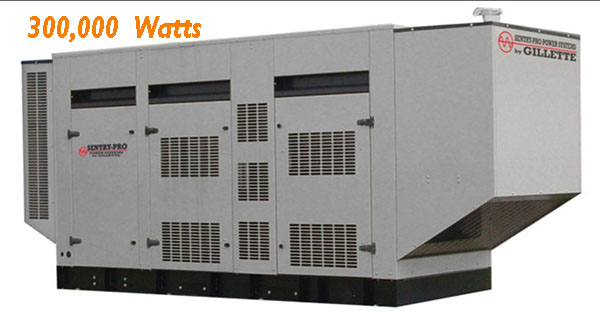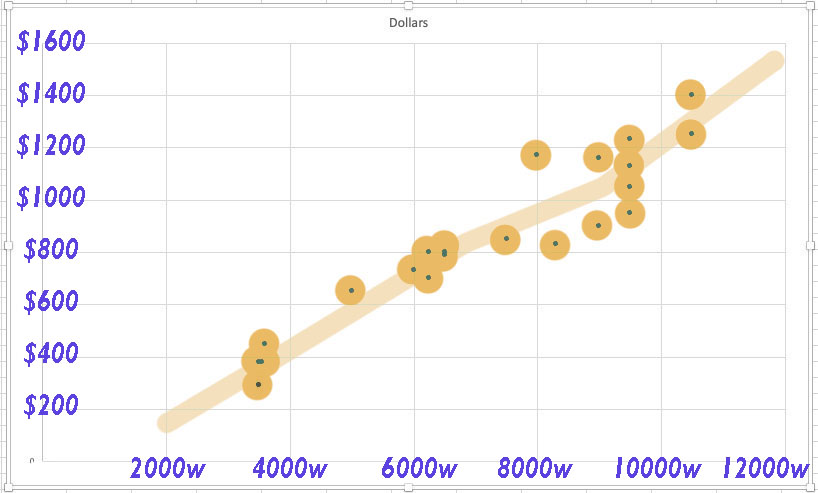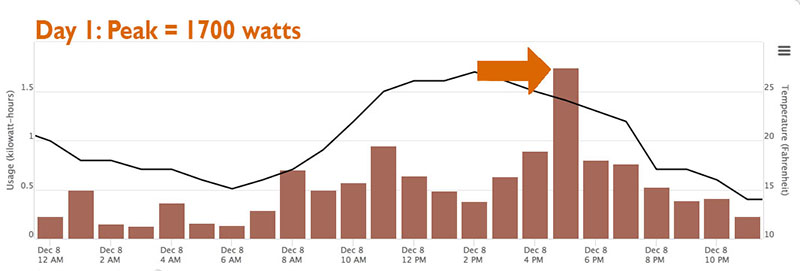
An emergency generator is a common next prep after the basics of some food and water are stored away. The question is; how big should it be? This post explores the variables so you can decide for yourself.
Generators come in all sorts of sizes. The answer to ‘how big’ your backup generator to buy is a bit like solving one of those three-variable algebra equations in math class. You loved those, right? There are more criteria to consider than just size, but we will focus just on size for now. The other factors can help you decided between comparably sized models, once you know the size you need.
It is no surprise that the bigger a generator is, the more devices (or bigger devices) it can run. Of course, the bigger it is, the more it costs. It is also no surprise that the bigger a generator is, the more fuel you’ll need to keep on-hand. Bigger isn’t automatically better.
Need vs. Nice
I recently got to see poor generator planning on a project at work. We had a client who wanted a backup generator for one of their aquatic exhibits. That is common enough among our clients. If the power goes out for very long, you don’t want all your expensive fish to die. Typically, such exhibits include backup plans to put just the minimum essential systems on a generator — just enough to keep the water oxygenated until the outage is over.
This client, however, was letting “would be nice” drive the bus. Ironically, they were (shall we say) a “frugal” client with a project that was already over budget by a million dollars. That is why I was a bit surprised to watch their “must have” list for the generator grow and grow.

Toward the end of the discussion, they wanted pretty much the entire building to be powered as if the grid had not gone down, including such things as AC for their office spaces. Their frugal sensibilities were shocked to hear that their long “essentials” list added up to 300 kilowatts. The architect told them that a generator that could supply that load would cost them over $150,000.
Kids, don’t try this at home
Don’t be like my client. When it comes to sizing an emergency generator for your home, it is easy to let the wish list can get out of hand too. It is good to keep in mind that you are planning for an emergency generator. Powering your entire house as though it were still connected to the grid is do-able, but seldom within the average “preps” budget.
While the grid is up, you can bake a cake while doing laundry and vacuuming the floors while the kids play internet games — all at the same time. If the grid goes down, do you really need to do all those things, and at the same time?
Unless you’ve got buckets of money, you will have to juggle the compromises. One or more of the generator variables — cost, capacity, or consumption — might have a ceiling for you in your situation and you’ll just have to live with it. That’s life.
First Variable: Cost
Bigger, more powerful, generators cost more than small ones. I know. Duh. But, it is good to keep this in mind as you think about the other two variables of capacity and consumption. Unless you are Mr./Ms DeepPockets, at some point you will wince at the price tag, just like my client winced (gasped out loud, actually) at their price tag.
Below is a chart I made of a selection of portable generators available from Home Depot. I did not tag the makes and models, as their selection varies by location and date. This is enough to illustrate the upward cost line. At the low end are 1000 Watt generators for under $200. At the upper end are behemoths like a 300 kW, natural gas unit for $150,000. (Not available at Home Depot, btw)

You can use this chart as a rough guide as you juggle the other two variables. Buying more than you need wastes money upfront and fuel costs down the line.
Second Variable: Capacity
Ah, but how much generator do you need? A good place to start, going in, is to know how much grid power your house consumes right now. Below are three usage charts for my house from my local power company. They were available online. You may be able to get such data for your house, too. I picked three random days. The more data you get, the more accurate you can determine your usage. These each show power consumption per hour for a 24 hour day.



I knew I did not consume the same amount of power at all hours of the day but I was surprised to see how extreme the spikes were. If my maximum peak day (Day 2 above) is representative of my max use, I would need at least a 4500-watt generator to cover that demand spike. Something to keep in mind is that my spike usage was non-emergency lifestyle usage (baking, laundering, vacuuming, etc.) and not an emergency lifestyle. But, if I decide that during an outage that I DO want to bake a cake, do laundry and vacuum at the same time, I now know how big of a generator I’ll need.
Notice too, the non-peak usage. It was actually quite low. If you chose to run your peak-handling generator 24 hours a day, much of the generated power would be wasted. This is the problem electric utility companies face every summer. They need to have generation stations big enough to supply the peak, but the rest of the time, those huge stations are pretty much idle.

Some people do that. I know an older lady who had a whole-house generator installed and fueled from two big propane tanks. When the power went out, her generator would kick on and run. It had the capacity to run her entire house. She would let it run continuously until the power came back on — even while she was sleeping. She is fairly well-off, so the installed cost and operating costs were not a big deal to her.
I’m not so well-off. Cost is a bigger deal to me.
Third Variable: Consumption
The bigger the generator’s motor, the more fuel it consumes per hour. Again, that’s not a shocker, but run out the math on fuel consumption and see where it takes you. It might surprise you.
Below are three generators, again, from Home Depot, with their fuel consumption rates.

Gen #1: 3,500W — 4-gallon tank, giving 10 hours of runtime (2.5 hrs / gal.)
Gen #2: 6,500W — 6.9-gallon tank, giving 10.5 hours of runtime (1.5 hrs / gal.)
Gen #3: 12,000W — 10.9-gallon tank, giving 9 hours of runtime (0.82 hrs / gal.)
Keep in mind that the rated runtimes of generators are usually based on a 50% load. So, for a 3500W generator to get close to its rated runtime, you can only draw 1750W. If you’re drawing near the generator’s rated capacity, the engine works harder and your fuel consumption will be higher.
That said, let’s look at how long each generator can run on 10 gallons of gas. (As a side note, keep in mind that having many gas cans stored around your home has its own share of issues to consider.)
For the sake of illustration, let’s assume each generator owner had stored two five-gallon gas cans of fuel and the generator kept empty until needed.
Generator 1’s owner could run his generator for 25 hours.
Generator 2’s owner could run his unit for 15 hours.
Generator 3’s owner could run his unit for 8.2 hours.
If they all kept their generators’ tanks full AND had ten more gallons, the numbers would be 35 hours, 25 hours, and 17.2 hours, respectively.
Even though 35 hours of runtime sounds like a lot, they are still finite numbers of hours. If you cannot get more fuel (such as an extended SHTF situation), that 35 hours would be all you get.
On and Off: The Third World Way
Having electricity for a few hours a day is normal for many people in third world countries. When the power is on, they do what they can. When the power is off, they make do and wait for the next “on” cycle. Modern westerners are not used to such a lifestyle. But, if we take a page from the Third World playbook, we can stretch our runtime significantly. Run the generator for only a portion of the day and do what you have to then.
From my daily usage charts above, you can see that I am already not using full power all day. I could run my generator for only four hours a day (just to pick a number) and arrange to do my peak consumption tasks during those four hours — Third World style.
Let’s say I bought Generator #2: 25 hours of runtime. At four hours a day, my fuel would last about 6 days. Almost a week sounds pretty good for the typical outage: not so much if it were an extended crisis.
If I cut my runtime to two hours a day, I could get twelve days. That sounds better, but I’m also doing half as much baking, vacuuming, etc.
Alternative Approach: Minimalism
If the price tag for a generator big enough to power your grid habits, you might consider a minimalist approach. Do a sort of energy-use triage to figure out what devices you really need to run and size your generator choice for that.
For example, my primary outage concern is keeping my fridge and freezer cold enough to preserve my existing food until I can eat it. (I’ve got wood for heat, a hand-pump well and oil lamps for light, so the fridge is the biggest “essential” power user. Your mileage will vary.) For my neighbor, his primary concern is water. He needs to power his 230v, 8 amp well pump. For a friend, being able to power oxygen accumulators for his aging parents is his primary concern.
My minimalist “need” is around 1000 watts. My neighbor’s need is about 2,000.
A little generator to provide 1000w would give me about five hours of runtime on a gallon of gas. Ten gallons would give me 50 hours! At two hours a day, that’s 25 days of use. Since my crucial need was to run my fridge, the odds are that I will have eaten all the food in the fridge within a week, and won’t need to run two hours a day every day. I can save the remaining fuel for other uses. A 6000W generator would be massive overkill for me.
My neighbor’s crucial need is to run his well pump (1900 watts). His 2500 watt generator runs about 3 hours on a gallon of gas. Ten gallons would give him 30 hours. If he ran his pump an hour a day (half hour to fill up a day’s barrel worth of water, and a half-hour for other things), he would have 30 days of generator power.
How much power does YOUR personal must-have list require?
Sharpen Your Pencils
As you can see in this three-variable math problem, you can get longer runtimes at the expense of capacity (wattage). You can get more wattage at the expense of runtime and cost, etc. You have to pick your priority.
The goal of this post is not to discourage you from adding a generator to your preps. No, indeed. They are great tools to have in your preps. The power contained in a single gallon of gasoline is truly amazing. A generator can improve the quality of your family’s time during an outage. An hour a day of watching a movie might keep your kids from strangling each other, for instance. That might be invaluable to you.
By carefully considering just how big of a generator you really need (not like my client did with their wish list), you can get the best bang for your limited bucks. By understanding your power-use priorities, you can maximize how long your fuel stores last. By understanding your consumption rate, you can calculate how much fuel to store if you have a specific duration in mind.
Having figured those three out, you have a good grasp on how your generator (and fuel) fit into your overall survival plan.
If you’ve already got a generator for your preparedness, how did YOU decide how big of a unit to buy? How much fuel do you typically keep on hand?
Next up: generator safety. Once you’ve selected your right-sized generator, how to use it safely.

As for cooking at our site, we use a rv stove hooked to propane. Baking and frying is done there or on a open fire. Washing clothes and running water well is for the generator. Freezer is running when other jobs are being done with generator on. Refig is a rv refig. Runs on propane.
Hehe. SoylentGreen Day. Great name. It kind of dates us, though.
Good point about alternate fuel sources. I’ve also got a propane grill with side burners for pot cooking and a cast iron dutch oven for small-scale baking. It sounds like you’ve got your energy management figured out.
How long do you figure your average propane supply would last you?
You neglected to that 99 percent of city and suburban areas use natural gas to run their generators
Hi Willie,
I was focusing more on small portable generators for home use. Natural gas for home generators isn’t too common where I live. Does the average suburban homeowner have natural gas-powered generators where you live?
I know some bigger corporate or institutional generators are natural gas. Big things, the size of trucks.
I have natural gas service where I live. I purchased a Winco tri-fuel generator which is just big enough to run my AC. I had the local gas company run a gas line to my patio where I can plug in my gas grill and my generator. I connect the electric to an outside plugin that is connected to my electric panel via an interlock. I also have a backup 2500 watt gasoline generator.
I have a 9000 watt gen that runs on gasoline….but I also added a propane kit for it so it is dual fuel….run time at 4500 w and 6 gallons of gas is about 24 hours, whole house, fall in NE MN…with propane it is 20 hours for a 20 gallon tank…..of course I store propane for emergency, but the gas tank is always full also, just in case the propane runs out in the middle of the night and I have to go re-start it early morning…..of course nobody runs everything for 24 hours.
Hi Lewis,
4 hours per gallon is pretty efficient. Have you figured out how many hours a day you’d plan to run your generator? As for ‘nobody runs everything for 24 hours,” it’s true that people don’t run their appliances that long, but there are people who want to leave their generator running 24 hours (like the older lady I mentioned). They like to duplicate the grid’s availability.
NE MN, eh? Iron Range?
That run time you touched on is very important. Mine runs 8-10hrs. My neighbor who was only interested in how quiet he could have his runs 4hrs.
What this meant was during the ice storm was I slept all night and he had to get up and refuel in the sleet. I’ll gladly trade the comforting hum for not going out and refueling.
I also wake when I no longer hear it which means I’d there is an issue, like it’s being stolen, oil sensor trips etc. I know it.
In SHTF neither will be running that long but in regular emergencies that factor is important.
Great article. Wish I’d had it before I started it 25yrs ago and learned some hard lessons.